PA5-112229
antibody from Invitrogen Antibodies
Targeting: PEG10
HB-1, KIAA1051, Mar2, Mart2, MEF3L, RGAG3, RTL2, SIRH1
Antibody data
- Antibody Data
- Antigen structure
- References [0]
- Comments [0]
- Validations
- Immunocytochemistry [3]
- Immunoprecipitation [1]
- Immunohistochemistry [2]
- Other assay [1]
Submit
Validation data
Reference
Comment
Report error
- Product number
- PA5-112229 - Provider product page

- Provider
- Invitrogen Antibodies
- Product name
- PEG10 Polyclonal Antibody
- Antibody type
- Polyclonal
- Antigen
- Other
- Reactivity
- Human
- Host
- Rabbit
- Isotype
- IgG
- Vial size
- 100 μL
- Concentration
- 1 mg/mL
- Storage
- Store at 4°C short term. For long term storage, store at -20°C, avoiding freeze/thaw cycles.
No comments: Submit comment
Supportive validation
- Submitted by
- Invitrogen Antibodies (provider)
- Main image

- Experimental details
- Immunocytochemistry-Immunofluorescence analysis of PEG10 in HepG2 cells. Cells were fixed with 4% PFA, permeabilized with 0.1% Triton X-100 in PBS, blocked with 10% serum, and incubated with PEG10 Polyclonal Antibody (Product # PA5-112229) (1:200) at 4°C overnight. Then cells were stained with the Alexa Fluor 488-conjugated Goat Anti-rabbit IgG secondary antibody (green) and counterstained with DAPI (blue). Positive staining was localized to Cytoplasm.
- Submitted by
- Invitrogen Antibodies (provider)
- Main image
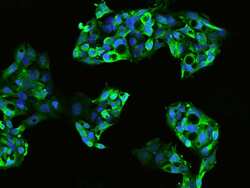
- Experimental details
- Immunocytochemistry-Immunofluorescence analysis of PEG10 in HepG2 cells. Cells were fixed with 4% PFA, permeabilized with 0.1% Triton X-100 in PBS, blocked with 10% serum, and incubated with PEG10 Polyclonal Antibody (Product # PA5-112229) (1:200) at 4°C overnight. Then cells were stained with the Alexa Fluor 488-conjugated Goat Anti-rabbit IgG secondary antibody (green) and counterstained with DAPI (blue). Positive staining was localized to Cytoplasm.
- Submitted by
- Invitrogen Antibodies (provider)
- Main image
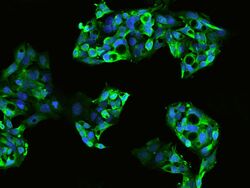
- Experimental details
- Immunocytochemistry-Immunofluorescence analysis of PEG10 in HepG2 cells. Cells were fixed with 4% PFA, permeabilized with 0.1% Triton X-100 in PBS, blocked with 10% serum, and incubated with PEG10 Polyclonal Antibody (Product # PA5-112229) (1:200) at 4°C overnight. Then cells were stained with the Alexa Fluor 488-conjugated Goat Anti-rabbit IgG secondary antibody (green) and counterstained with DAPI (blue). Positive staining was localized to Cytoplasm.
Supportive validation
- Submitted by
- Invitrogen Antibodies (provider)
- Main image

- Experimental details
- Immunoprecipitation of PEG10 was performed on (Lane A) 0.5 mg HEK 293 whole cell lysate using 4 µL of PEG10 Polyclonal Antibody (Product # PA5-112229) at a dilution of 1:100, and 60 µg of Immunomagnetic beads Protein A/G. A Goat Anti-Rabbit IgG (H+L)/HRP was used as a secondary antibody at a dilution of 1:10,000. Developed using the ECL technique and performed under reducing conditions. Predicted band size: 30 kDa. Observed band size: 100 kDa.
Supportive validation
- Submitted by
- Invitrogen Antibodies (provider)
- Main image
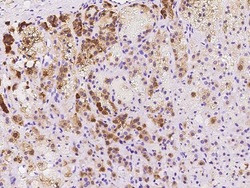
- Experimental details
- Immunohistochemistry analysis of PEG10 in formalin-fixed paraffin embedded sections human adrenal gland tissue sections using PEG10 Polyclonal Antibody (Product # PA5-112229) at a dilution of 1:1000.
- Submitted by
- Invitrogen Antibodies (provider)
- Main image
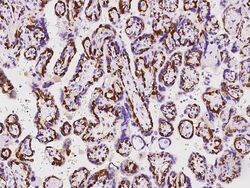
- Experimental details
- Immunohistochemistry analysis of PEG10 in formalin-fixed paraffin embedded sections human placenta tissue sections using PEG10 Polyclonal Antibody (Product # PA5-112229) at a dilution of 1:1000.
Supportive validation
- Submitted by
- Invitrogen Antibodies (provider)
- Main image
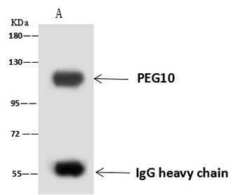
- Experimental details
- Immunoprecipitation of PEG10 was performed on (Lane A) 0.5 mg HEK 293 whole cell lysate using 4 µL of PEG10 Polyclonal Antibody (Product # PA5-112229) at a dilution of 1:100, and 60 µg of Immunomagnetic beads Protein A/G. A Goat Anti-Rabbit IgG (H+L)/HRP was used as a secondary antibody at a dilution of 1:10,000. Developed using the ECL technique and performed under reducing conditions. Predicted band size: 30 kDa. Observed band size: 100 kDa.
 Explore
Explore Validate
Validate Learn
Learn Western blot
Western blot Immunocytochemistry
Immunocytochemistry